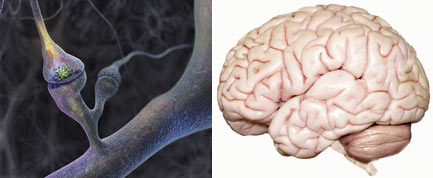Left vs. Right: Battle in Brain Discovered

Most animals, including humans, have functionally lopsided brains. Some things are processed in the left hemisphere, others on the right side. While some of the differences are learned and others inherited, the spectrum of possibilities indicates something more random may be at work, too.
A new study of zebrafish embryos suggests a tug-of-war in the developing brain is responsible for at least part of this asymmetry.
Researchers have known that brain cells called neurons migrate long distances in a developing brain. The battle to attract nerve cells to one side or the other is governed by a protein called Fgf8, the new study found. The protein acts as a magnet to attract nerve cells to one hemisphere of the brain.
The result is "differences in the types of neurons on left and right and in their connections," said Professor Stephen Wilson of University College London. "Absolute numbers of cells are, we think, similar between the two sides."
The research, published last week in the journal Neuron, was funded by the Wellcome Trust.
Unfair fight
There's a long-standing myth, related to Scottish lore, that left-handers (who have always made up 10 to 12 percent of the human population) are better fighters. Another unproven adage holds that lefties are smarter. True or not, handedness might be tied to a war of sorts, in the brain.
Get the world’s most fascinating discoveries delivered straight to your inbox.
Both sides of the brain contain Fgf8, leading to a tug-of-war to attract certain migrating nerve cells, said Wilson's colleague, Ph.D. student Jenny Regan. "This isn't a fair fight, however," Regan said. "Fgf8 on the left-hand side has an ally to help it win the battle."
Another protein, called Nodal, is present only on the left side of the brain. When it teams up with Fgf8, the pair wins, causing a predictable pattern of neuron connections in the left hemisphere that "helps to explain why there is consistent handedness between individuals," at least among zebrafish, Regan and Wilson explained in a statement.
But if Nodal is somehow inhibited, the competition is fairer and there's an equal probability for the left or right winning the tug-of-war.
"The decision to become right-brained or left-brained is due to a competition between the two sides of the brain," Wilson explained. "If the competition was fair and equal, then half the population would be left-brained and half would be right-brained. However there are signals on the left side of the brain that give it an advantage so in most cases it 'wins.'"
Human handedness
Because the work was done on fish embryos, Wilson told LiveScience it does not necessarily explain why most people are right-handed and others prefer the left. But if offers an intriguing new line of research.
Wilson notes that brain asymmetry is far more complex than just a simple left vs. right equation.
"Nearly all right-handers also process language in the left hemisphere, but lots of left-handers also have language production localized to the left," he said. "This suggests that although preferential hand usage and language lateralization usually go together on one side of the brain, they can be separated."
Some people throw a ball right-handed but write with the left. Others have a certain preference for which arm goes on top when folded. Others have a dominant eye.
"Some of these asymmetries might be genetically determined, some may be reinforced by behavior and some might be randomly assigned" based on one or more tug-of-war battles between the two sides of the brain, Wilson explained.
Why it matters
It's all nature's way of ensuring the brain ultimately compartmentalizes tasks to maximize efficiency.
"Brain asymmetry is essential for proper brain function," Wilson said. "It allows the two sides of the brain to become specialized, increasing its processing capacity and avoiding situations of conflict where both sides of the brain try to take charge."
Wilson explains: Faced with a predator, you wouldn't want both sides of your brain running the escape effort and potentially causing conflict. Better to have one side working on the getaway with the other handling other vital tasks, such as keeping an eye on the predator.
Previous studies have borne out this exact scenario, showing that raising chickens in the dark decreases brain asymmetry. The chicks can peck for food. And they can watch for predators. But if they have to do both at once, they're less efficient at each task than chicks with fully asymmetric brains that were raised in daylight.
The new findings could eventually lead to better understandings of brain deficiencies. For instance, in humans, people with schizophrenia have disrupted brain asymmetries but as yet, it is not clear if there is a causal link between the asymmetry and schizophrenia.
"Schizophrenia is sometimes associated with less strong right or left-handedness, and this might be linked to altered brain asymmetry," Wilson said. "More research both in model systems like the zebrafish and in humans will be needed to resolve these and related issues."
- Brain Food: How to Eat Smart
- Brain Chip to Stimulate Orgasms
- Brain News and Information
Robert is an independent health and science journalist and writer based in Phoenix, Arizona. He is a former editor-in-chief of Live Science with over 20 years of experience as a reporter and editor. He has worked on websites such as Space.com and Tom's Guide, and is a contributor on Medium, covering how we age and how to optimize the mind and body through time. He has a journalism degree from Humboldt State University in California.



